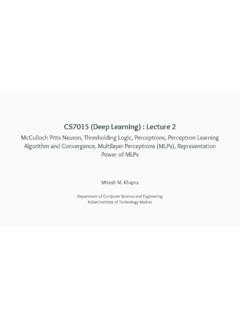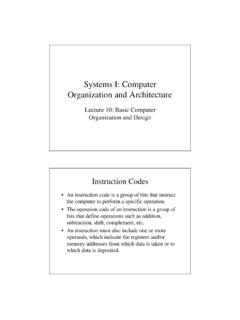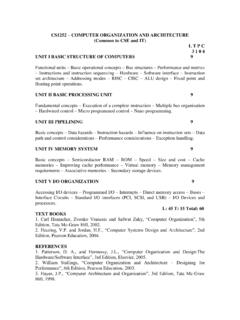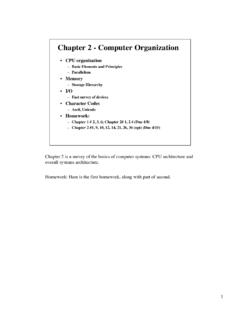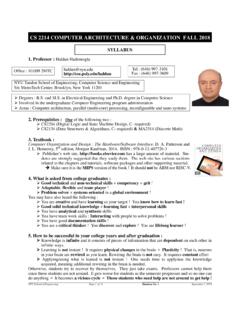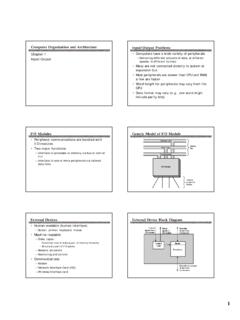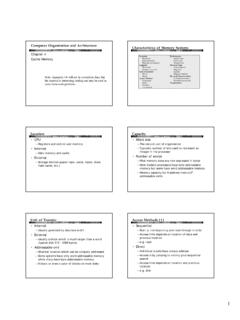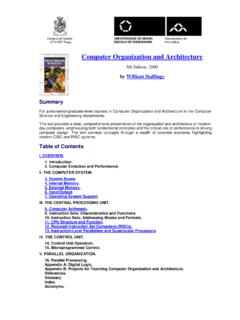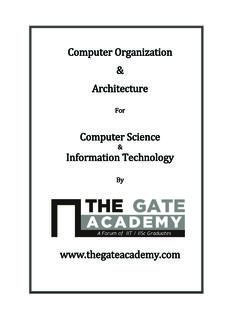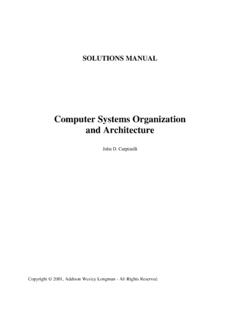Transcription of CS2600 - Computer Organization
1 CS2600 - Computer OrganizationSUKHENDU ~sdas@ - Computer OrganizationSyllabus: Introduction: Function and structure of a Computer Functional components of aIntroduction: Function and structure of a Computer , Functional components of a Computer , Interconnection of components, Performance of a Computer . Representation of Instructions: Machine instructions, Operands, AddressingRepresentation of Instructions: Machine instructions, Operands, Addressing modes, Instruction formats, Instruction sets, Instruction set architectures - CISC and RISC architectures. Processing Unit: Organization of a processor - Registers, ALU and Control unit, Data path in a CPU, Instruction cycle, Organization of a control unit - Operations of a control unit, Hardwired control unit, Microprogrammed control unit.
2 Memory Subsystem: Semiconductor memories, Memory cells - SRAM and DRAM cells, Internal Organization of a memory chip, Organization of a memory unit, Error correction memories, Interleaved memories, Cache memory unit - Concept of cache memory, Mapping methods, Organization of a cache memory unit, Fetch and write mechanisms, Memory management unit - Concept of virtual memory, Address tltiHdtfttranslation, Hardware support for memory management. Input/Output Subsystem: Access of I/O devices, I/O ports, I/O control mechanisms -Program controlled I/O Interrupt controlled I/O and DMA controlled I/O I/O interfacesProgram controlled I/O, Interrupt controlled I/O, and DMA controlled I/O, I/O interfaces - Serial port, Parallel port, PCI bus, SCSI bus, USB bus, Firewall and Infiniband, I/O peripherals - Input devices, Output devices, Secondary storage C.
3 Hamacher, Z. Vranesic and S. Zaky, " Computer Organization ", McGraw-Hill, W. Stallings, " Computer Organization and architecture - Designing for Performance", Prentice Hall of India, D. A. Patterson and J. L. Hennessy, " Computer Organization and Design -The Hardware/Software Interface", Morgan Kaufmann, J .P. Hayes, " Computer architecture and Organization ", McGraw-Hill, Level HierarchyProgram ExecutionTranslation: The entire high level program is translated into an equivalent machine language program. Then the machine language program is is : Another program reads the high level programInterpretation: Another program reads the high level program instructions one-by-one and executes a equivalent series of machine language translationuses a collection of tools to perform the translation: Compiler:Translates high level language programs into a lower level language often called object code.
4 Assembler:Translates assembly language instructions into object code. Linker:Combines collections of object code into a single executable machine language System: Layers of AbstractionComputer System: Layers of AbstractionApplication ProgramApplication ProgramAlgorithmsSoftwareHardwareLanguag eItti S t A hittInstruction Set architecture (and I/O Interfaces) MicroarchitectureMicroarchitectureCircui tsDevicesFrom Theory to PracticeFrom Theory to PracticeIn theory, Computer can computeanything that s possible to compute given enough memoryand timeIn practice, solving problemsinvolves tidt i tcomputing under constraints. time weather forecast next frame of animation weather forecast, next frame of animation.
5 Cost cell phone, automotive engine controller, .. power cell phone, handheld video game, ..Transformations Between LayersHow do we solve a problem using a Computer ?A systematic sequence of transformations between layers of of Design:choose algorithms and data structuresAlgorithmProgramming:use language to express designProgramggpgCompiling/Interpreting: Instr SetAhit tCompiling/Interpreting:convert language to machine instructionsArchitectureDeeper and DeeperDeeper and SetArchitectureProcessor Design:Microarchchoose structures to implement ISAL ogic/Circuit Design:Logic/Circuit Design:gates and low-level circuits toimplement componentsCircuitsProcess Engineering & Fabrication.
6 Develop and manufactureDevicesdevelop and manufacturelowest-level componentsDescriptions of Each LevelDescriptions of Each LevelProblem StatementProblem Statement stated using "natural language" may be ambiguous imprecisemay be ambiguous, impreciseAlgorithm step-by-step procedure, guaranteed to finishpypp,g definiteness, effective computability, finitenessProgram express the algorithm using a Computer language high-level language, low-level languageInstruction Set architecture (ISA) specifies the set of instructions the Computer can performdata types addressing mode data types, addressing modeDescriptions of Each Level (cont )Descriptions of Each Level (cont.)
7 MicroarchitectureMicroarchitecture detailed Organization of a processor implementation different implementations of a single ISAdifferent implementations of a single ISAL ogic Circuits combine basic operations to realize microarchitecturep many different ways to implement a single function ( , addition)DiDevices properties of materials, manufacturabilityMany Choices at Each LevelMany Choices at Each LevelSolve a system of equationsGaussian eliminationJacobiiterationRed-black SORM ultigrideliminationiterationgFORTRANCC++ JavaTradeoffs:Intel x86 Sun SPARCC ompaq AlphacostperformancepowerPentium IIPentium IIIAMD Athlon(etc.)Ripple-carry adderCarry-lookahead adderCMOSB ipolarGaAsWhat s NextBits and Bytes How do we represent information using electrical signals?
8 How do we represent information using electrical signals?Digital Logic How do we build circuits to process information?How do we build circuits to process information?Processor and Instruction Set How do we build a processor out of logic elements?pg What operations (instructions) will we implement?Assembly Language Programming How do we use processor instructions to implement algorithms? How do we write modular reusable code? (subroutines) How do we write modular, reusable code? (subroutines)I/O, Traps, and Interrupts How does processor communicate with outside world?How does processor communicate with outside world?Structure and Function of a Computer SYSTEM:illiA Computer is a complex system; For analysis, understanding and design - Identify the hierarchical nature of most complex system hierarchical nature of most complex system.
9 A hierarchical system is a set of interrelated ysubsystems, each in turn, hierarchical in structure; until at the lowest level we have elementary hierarchical nature of complex systems is The hierarchical nature of complex systems is essential to both their design and their description. The designer need only deal with a particular level gypof the system at a time. At h ll th t i t f t f At each level, the system consists of a set of components and their interrelationships. The behavior at each level depends only on a simplified, abstracted characterization of the system at the next lower level.
10 At each level, the designer is concerned ,gwith structure and function:hihihhStructure: The way in which the components are interrelated. Function:The operation of each individual component as part of the structure. ppCentral Processing Unit (CPU) based COThe Organization of a simple Computer with one CPU and two I/O devicesThere are four main functionsof a Computer :i Data processing Data storage Data movement Data movement ControlMAIN STRUCTURAL BLOCKS/PARTS:Ct l Pi U it (CPU)Ct l th ti f Central Processing Unit (CPU):Controls the operation of the Computer and performs its data processing functions. Often simply referred to as processor.

